Porcelain Insulator News
by Jack H. Tod
Reprinted from "INSULATORS - Crown Jewels of the Wire", April 1975, page 19
Preferably direct porcelain news items and questions directly to Jack H. Tod,
3427 N. 47th Place, Phoenix, Ariz. 85018. All mail will be answered if reply
stamp is enclosed, and the most newsworthy item and questions of general
interest will be published as space permits.

We have for a long time attributed the U-188 Dry-Spot insulator to Automatic
Electric Co., and it is commonly found with the A. E. Co. INC. marking shown
above. Indeed, this insulator was sold by Automatic Electric from 1929 to 1951
and was first cataloged by them in July 1929.
But a hitch developed. In 1972, a U-188 specimen turned up with the
"AMERICAN ELEC CO INC" marking shown above (see Crown Jewels, Nov
1972, page 18). It is nearly identical with the A. E. Co. specimens, the skirt
being a bit shorter and flared out more. The company name is recess-embossed
instead of being permanently marked on the dies as with the embossed A. E. Co.
INC. marking.
One other fact led me to believe we should properly attribute the U-188 to
American Electric Co. instead of Automatic Electric Co., and I have spent
considerable time and effort in the past two years trying to dig up facts which
would prove this to be correct. I have in my files a copy of the original
engineering draft of the Automatic Electric Co. sales sheet on this Dry-Spot
(dated July 1, 1929). It uses identical photo cuts from another catalog page
134, most probably that of American Electric Co., and the typed draft of the
sales sheet has the word "Amerelec" inserted with a caret before each
use of the words "Dry-Spot insulator".
As stated in the 1973 Supplement B to my book, all we needed to do was locate
the patent on this item to settle the question. This was no easy task, since I
am now convinced there was no patent granted on this insulator! I have
personally checked all the 2946 patents for insulators under Class 174, nearly
1,000 other insulator-related patents under other classifications, and every
single patent (nearly 1900) ever issued to American Electric, Automatic Electric
and associated companies from 1920 through 1936.
The U-188 is identical in principle to the British screw-top Dry-Spot patent
(#898,921 of Sep 15, 1908) except that the U-188 has a dry chamber for two wires
instead of one as on the British design. I imagine the examiners denied American
Electric an application and that Square-D Co. (who made all the U-188's) never
removed the "PAT. PEND'G." marker strip from the dies. Note though
that they did at some time remove the temporary marker strip with "AMERICAN
ELEC CO INC" and permanently mark the dies with the A. E. Co. INC.
designation.
Automatic Electric Co., Chicago was established in 1891 and became Automatic
Electric Co., Inc. In 1926.
American Electric Co., Chicago was established in 1893.
Both companies were in the telephone equipment supply business and also had
other interests in the United States and in England, two being Automatic
Electric Co., Ltd. of London and Associated Telephone & Telegraph Co.,
Chicago (physical facilities in England).
Two or more of these various companies, including both American Electric Co.
and Automatic Electric Co., were involved in some form of corporate merger in
about 1929 and became Associated Electric Labs, Inc., Chicago.
All this may be boring to those who just sit insulators on the shelf because
they're pretty, but it may be of interest to those who care about who created
the designs, who made them and what they were used for. It simply bugged me that
we were giving credit to the wrong company for having originated the U-188
Dry-Spot insulator. As far as I'm concerned, American Electric Co., Inc. gets
credit for what Automatic Electric Co. called the "Amerelec Dry-Spot
insulator".
Dear Jack:
... and that white primary fuse cutout in the other photo is a real odd one
with those double horns on each side of the top. It's embossed "CAT No
87439 / FORT WAYNE ELECTRIC WORKS / WOOD PATENT AUG. 11, 1903". Jerry Turner
Goshen, Ohio
- - - - - - - - -
Yep, I'll agree it's a real oddball, and here is the O.G. clipping of the
patent on it, horns and all.
Jack
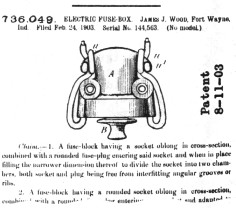
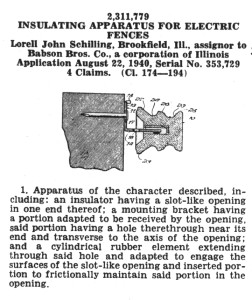 |
Image text:
2,311,779 INSULATING APPARATUS FOR ELECTRIC FENCES Lorell John Schillking,
Brookfield, Ill., assignor to Babson Bros. Co., a corporation of Illinois
Application August 22, 1940, Serial No. 353,729 4 Claims. (Cl. 174--194)
1. Apparatus of the character described, including: an insulator having a
slot-like opening in one end thereof; a mounting bracket having a portion
adapted to be received by the opening, said portion having a hole therethrough
near its end and transverse to the axis of the opening; and a cylindrical rubber
element extending through said hole and adapted to engage the surfaces of the
slot-like opening and inserted portion to frictionally maintain said portion
in the opening.
|
Note the Babson knobs on Page 19, Feb 1975 Crown Jewels and earlier
references. Here is a Feb 23, 1943 letters patent on this item.
Notice the slot-like pin hole in the insulator is for use with an angle
bracket, and the knob just pushes onto this. If you want to call this metal
bracket a "pin", you might stretch your terminology and call this a
"threadless". No way.
Has anyone ever found any of these besides the single specimen reported in
the Nov 1971 issue?

Dear Jack:
In the January column you ask about the Gisborne Pattern insulators. The
attached pages are recopied from the book Canadian Insulators (pages 42 thru
45), by Colin McIntosh, 4063 W. Saanich Rd,, Victoria, B.C.
I have a cobalt blue, unmarked porcelain insulator like the attached drawing.
If you have any information on this, I would appreciate it. I believe it is a
strain.
Al Albright,
Seattle
- - - - - - - - -
Dear Al:
Many thanks for info on Gisborne, and this and more sent by others will be
in next month's column.
I have no information on the insulator you have (sketch above), but after all
the thought I can give it, I believe you are right that it in a strain. If so,
it was probably for use with radio antenna kits.
There are a couple of patents on such strains with the petticoat idea like
this, the reason for it being obvious. Assuming our hunch is correct, this is in
the "goody" class for anyone collecting radio antenna insulators.
Jack
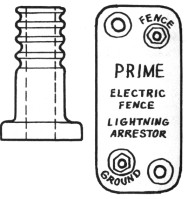
Dear Jack:
I found the insulator at the left last summer while digging bottles. It was
found on the edge of a swamp. It has a reddish-brown glaze, with 7/8" hole
going through it. There are no identifying marks on it, and it is in mint
condition . Who do you think made it, and what was it used for?
The insulator on the right is an electric fence lightning arrestor. I found
this in a barn on an old farm. Could you tell me how old it is, and what it is
worth?
I am 16 years old and a serious collector of insulators. I enjoy your column
and Crown Jewels very much. This information will be greatly appreciated.
Brian
D. Goetsch
Rt 3, Box 321,
Lake Villa, ILL. 60046
- - - - - - - - -
Dear Brian:
I know nothing about your item at left, but I presume it is some type of an
electrical equipment bushing -- if it is an electrical item.
Your PRIME electric fence insulator is interesting, since small blue and
brown knobs with this marking keep showing up, and now we know they were part of
electric fence kits sold by some company (unknown to me).
Value? Most lightning arrestors like these sell for $.25 to $1 or so, but this
one for use with electric fences is more unusual. I can't say what others might
value it, but I would give $2 plus postage to add it to my collection of
electric fence insulators.
Jack
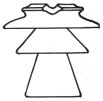
Dear Jack:
I don't collect porcelain insulators, but I read your column in Crown
Jewels.
I found these insulators at a rummage barn, and could not recall reading about
any in this color.
These insulators are cobalt blue, three-piece, substation type. They have a
one inch metal pin that is cemented in. One of them is marked "JUN 22"
and either P.P., P.H. or P.K. The top skirt is 9-1/2" diameter, and they
are 9" tall.
All of them have some cracks, but only one has any porcelain missing. If you
could, I would like to know how rare they are. Also if they are worth anything.
Burney Mangum,
San Antonio
- - - - - - - - - -
Dear Burney:
It stands to reason that some utility companies somewhere must have had
occasion to order cobalt blue multiparts, either for substation or pole line
use, but I don't recall having seen any in my travels. Even in all my insulator traveling, I probably haven't been in the areas of more than 5% of the
utilities in the country though.
In any event, I would agree with you that these are unusual in cobalt blue. I
wouldn't care to hazard a guess as to collector value, but don't get your hopes
up too high. Non-mint multis with "stuck pins", even in cobalt blue,
aren't exactly the rage of the day.
Jack
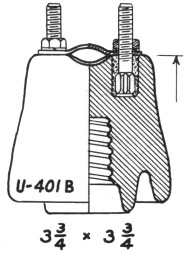
Dear Jack:
Enclosed is a shadow profile drawing and a photo of an insulator I bought
in Wooster, Ohio for $1.00 (he got it in Penna.).
I would like to know what it is and made by whom? When? Where? How the
insulator was used and voltage limits?
It is marked IEP / 1958 on the skirt. It was fired upright, and the studs on
top are leaded into holes in the porcelain. Dave Harting
N. Canton, Ohio
- - - - - - - - -
Dear Dave:
Your insulator was made by McGraw-Edison, Macomb, Illinois.
The IEP marking during the 1958 period stood for Illinois Edison Porcelain. I
knew nothing about this insulator, so I wrote the factory about it. Here's the
info.
Their shop drawing on it (insulator #3328) is dated 1954. The insulator is
described as a "duplex bracket" and is used in low voltage
distribution installations as an alternate to spool insulators, and maybe in
special construction applications.
The size of the unit should insulate a line up to about 5 Kv, and 2.4 Kv
would be the more typical application. This item is now an obsolete item with
McGraw-Edison, but change notices on the drawing indicate it may have been
manufactured up until 1961 or thereabouts.
The ones made by McGraw were sold through their Divisional Sales force and
could have gone to any electric utility.
This is a pin type in our terminology, and it will be U-401B in the style
chart. Getting such an unusual porcelain pin type for $1.00 could lead to your
getting a guilt complex -- you lucky devil!
Jack
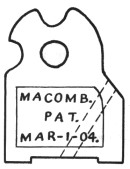
Dear Jack:
I read your news in Crown Jewels every month and really enjoy it. I'm not
really an involved collector but enjoy them just the same.
Recently we found some insulators around an old farm house, and I have
enclosed sketches of some of these. Any information on the markings would be
helpful, and could you give me an idea of their value and if someone might want
to trade for them? I would rather trade them than sell them in order to build a
collection.
I have two of these knobs (shown above). One type has markings "MACOMB /
PAT / MAR-1-04 /// S-H Co. / No. 1". The other is "T. P. Co. / PAT /
MAR-1-04 /// N. W . Co. / No. 1"
We also found regular wiring cleats with markings of FEDCO, MACOMB, TRENLE
and WESTERN ELECTRIC. David Fisher,
5605 Vermont St. SW
Cedar Rapids, Iowa 52404
- - - - - - - - -
Dear David:
Your special knob originated with the Snyder-Hunt Co., Belle Plain, Iowa and
is covered by their patent #753,399 of March 1, 1904. (See patent O.G. clip in
Gerald Brown's 2nd Edition, page 34.) The S-H Co. in Snyder-Hunt Co. These were
made by a number of porcelain companies during the patent term and also probably
after the patent expired in 1921, judging from your specimen with the N. W. Co.
marking in place of the usual S-H Co. marking on one side.
Your other markings on these are: MACOMB is trademark of Illinois Electric
Porcelain Co., Macomb, ILL. (1910-53) T. P. Co. is Trenton Porcelain Co., an
insulator jobber in Trenton who had their insulators made by various porcelain
companies. The N. W. Co. I know nothing about.
Value on these S-H knobs in $1 to $2 or so, maybe more to someone chasing
certain markings on them.
Other markings on your #334 cleats are: FEDCO is Federal Porcelain Co.,
Carey, Ohio (1917-1927). TRENLE is The Trenle Porcelain Co., E. Liverpool, Ohio
(1917-1937). WESTERN ELECTRIC is Western Elec., New York City, cleats made for
them by various porcelain companies. Later ones marked WESCO for Western
Electric Supply Co.
Collector value on #334 cleats varies on markings, but they are a trade item
between those who collect them. I'll pay $.50 plus postage for any one I don't
have or will swap two of my dupes for one I don't have.
Jack
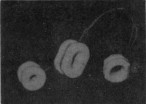
Dear Jack:
I've enclosed a photo and some sketches of three insulators that were found
on an old line that was built in the mountains in British Columbia. It was built
I believe in the late 1800's, and is not in use now. The insulators were used as
tree insulators.
The one on the left is embossed "T", the middle one embossed
"G", the one on the right "THOMAS / MADE IN U.S.A."
I thought that you might be able to give me some information on them.
Lorne
E. Horton,
42 Porteous Cres.,
Saskatoon, Sask. SW 2S8, Canada
- - - - - - - - -
Dear Lorne:
Your forestry insulators are as follows:
Left--Standard porcelain #37-Split,
still possibly an item of manufacture with some companies. "T" =
Thomas
Center--U.S. Standard D-1 Forestry insulator, design originating in the
1930's and still an item of manufacture. The THOMAS is for R. Thomas & Sons
Co., E. Liverpool, Ohio (but Lisbon, Ohio only after 1927 and until 1963).
Right--Standard porcelain #22 Victor. Design originated in 1899 with the E.
S. Greeley & Co. patent shown here. Note the flat sides and more oblong
shape. The only one I've seen is in the collection of Larry Thomas (Calif.), and
it has an Imperial Porcelain Works marking.
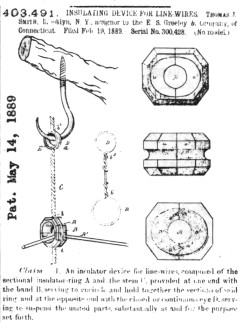
Modern version like yours is more round and is still manufactured by at least
3 companies. The "G" marking is still our unattributed mystery
marking, but I believe it's Globe Porcelain Co, Trenton (1913-1960's).
All these types and similar ones have long been very commonly used in
forested areas for alarm (fire lookout) lines and private phone lines of all
sorts, most of which have been replaced by radio. Here in Arizona, for instance,
there were hundreds of these lines, and these "doughnuts" as we call
them are hanging from trees everywhere you go up in the mountains. In most cases
the old galvanized wire has been taken up, since it's a hazard to livestock and
wildlife if they become entangled in the down lines.
Collector value on all these items is $1 to $2 at most because of ready
availability.
Jack
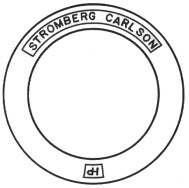
Dear Jack:
I traded for a white U-47 exchange that is recess-embossed on the rim as
shown in the attached sketch. I'm not sure of the "CARLSON" part, as
it's hard to read with a magnifier, and that seemed most logical. Upon looking
in my collection, I find a similar one with some rim embossing also from Canada
about 3 years ago. Would you please identify it for me?
Robert M. Hines
Went Monroe, La.
- - - - - - - - -
Dear Robert:
We ran this answer in the Aug 1872 column, page 19, but guess it wouldn't
hurt to repeat it now.
A number of different white U-47 are all found mixed on lines in Canada, and
markings on them are:
- HP / STROMBERG CARLSON
- HP / MADE IN CANADA --- CIS (on crown)
- MADE IN CANADA /
STROMBERG CARLSON
- ----- nothing on rim ----- P. P. INC. (on crown)
The monogram-HP is the trademark of Hamilton Porcelains Ltd., Brantford,
Ontario, Canada. They advised they made these insulators in the 1930 to 1945
period.
Stromberg Carlson (established 1872) was headquartered in Rochester, N.Y. and
dealt in telephone supplies.
The CTS is for Chicago Telephone Supply Co. (established 1896), and they also
sold telephone supplies.
P.P. Inc. originated in 1927 with the merger of several U.S. porcelain
manufacturers, and they made U-47 with the P.P. INC. marking at their Findlay
plant until it was shut down a few years after the 1927 merger.
All of the insulators with the above 4 markings were made on identical dies
except for the applied markings.
Now, if you feed all the above facts into your computer, you come up with the
solution that Hemingray made glass insulators and there are precisely 11.44375
board feet of lumber in a standard 10' crossarm. It does not prove that Hamilton
Porcelain bought the U-47 dies from P.P. when they shut down the Findlay plant.
Jack
| 